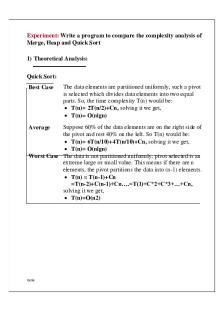Heap Sort Priority Queues 1 PDF

| Title | Heap Sort Priority Queues 1 |
|---|---|
| Course | Algorithm & Data Structure Analysis |
| Institution | The University of Adelaide |
| Pages | 17 |
| File Size | 585.1 KB |
| File Type | |
| Total Downloads | 61 |
| Total Views | 140 |
Summary
By mingyu...
Description
Algorithm and Data Structure Analysis (ADSA) Lecture 9: Priority Queues/Heapsort
Algorithm and Data Structure Anal
1
Heap OperaEons: BuildHeap We can build a heap in a boJom up manner by running on successive subarrays Fact: for array of length n, all elements in range A[ n/2 + 1 .. n] are heaps (Why?) So: Walk backwards through the array from n/2 to 1, calling on each node. Order of processing guarantees that the children of node i are heaps when i is processed Algorithm and Data Structure Anal 3 9/07/14
BuildHeap
Algorithm and Data Structure Anal 4 9/07/14
BuildHeap() xample Work through example A = {4, 1, 3, 2, 16, 9, 10, 14, 8, 7} 4 1
3
2 14
16 8
9
7
Algorithm and Data Structure Anal 5 9/07/14
10
Analyzing BuildHeap ach call to takes O(lg n) Eme There are O(n) such calls (speci cally, n/2 ) Thus the running Eme is O(n lg n) Is this a correct asympto2c upper bound? Is this an asympto2cally 2ght bound?
A Eghter bound is O(n) How can this be? Is there a aw in the above reasoning? Algorithm and Data Structure Anal 6 9/07/14
Analyzing BuildHeap: Tight Theorem: The heap implementaEon realizes build in Eme O(n). Proof: There are at most 2l nodes of depth l (from root). A call of Heapify for each of these nodes takes Eme O(k l), k depth of the tree. Get total runEme by summing up l=0, …, k 1 Algorithm and Data Structure Anal 7 9/07/14
Theorem: The heap implementaEon realizes BuildHeap in Eme O(n). Proof: There are at most 2l nodes of depth l. A call of si down for each of these nodes takes Eme O(k l), k height of the tree. Get total runEme by summing up l=0, …, k 1
Algorithm and Data Structure Anal
8
Proof RunEme Build Total runEme:
xplanaEon:
Algorithm and Data Structure Anal
9
Heapsort Want to have a SorEng algorithm based on heaps that runs in Eme O(n log n). Idea: Build the heap for n elements in Eme O(n). Pick in each step the maximum element (root) and delete it. (Time O(log n)) Iterate unEl heap is empty. In total n iteraEons implies total runEme O(n log n) Algorithm and Data Structure Anal
10
Heapsort Given , an in place sorEng algorithm is easily constructed: Maximum element is at A[1] Discard by swapping with element at A[n] Decrement heap_size[A] A[n] now contains correct value
Restore heap property at A[1] by calling Repeat, always swapping A[1] for A[heap_size(A)] Algorithm and Data Structure Anal 11 9/07/14
Heapsort
Algorithm and Data Structure Anal 12 9/07/14
Analyzing Heapsort The call to takes O(n) Eme ach of the n 1 calls to takes O(lg n) Eme Thus the total Eme taken by = O(n) + (n 1) O(lg n) = O(n) + O(n lg n) = O(n lg n)
Algorithm and Data Structure Anal 22 9/07/14
Priority Queues Heapsort is a nice algorithm, but in pracEce Quicksort (coming up) usually wins But the heap data structure is incredibly useful for implemenEng priority queues A data structure for maintaining a set S of elements, each with an associated value or key Supports the operaEons , , and What might a priority queue be useful for? Algorithm and Data Structure Anal 23 9/07/14
Priority Queue OperaEons Insert(S, x) inserts the element x into set S Maximum(S) returns the element of S with the maximum key ExtractMax(S) removes and returns the element of S with the maximum key How could we implement these opera2ons using a heap? Algorithm and Data Structure Anal 24 9/07/14
ImplemenEng Priority Queues ’
ImplemenEng Priority Queues
ImplemenEng Priority Queues...
Similar Free PDFs

Heap Sort Priority Queues 1
- 17 Pages

Priority Queues
- 13 Pages

INSERTION SORT
- 12 Pages

Binary heap - Lecture notes 1
- 9 Pages

Chapter 06 - Heap Corruption
- 43 Pages

Word Sort examples
- 81 Pages

Priority lab tests - ATI
- 1 Pages

Dual Degee Priority 1 offer Goa
- 6 Pages

Program for Merge Sort
- 6 Pages

Shell Sort (Metode Shell
- 56 Pages

Bubble Sort Algorithm
- 10 Pages

1.3 Priority population groups
- 1 Pages
Popular Institutions
- Tinajero National High School - Annex
- Politeknik Caltex Riau
- Yokohama City University
- SGT University
- University of Al-Qadisiyah
- Divine Word College of Vigan
- Techniek College Rotterdam
- Universidade de Santiago
- Universiti Teknologi MARA Cawangan Johor Kampus Pasir Gudang
- Poltekkes Kemenkes Yogyakarta
- Baguio City National High School
- Colegio san marcos
- preparatoria uno
- Centro de Bachillerato Tecnológico Industrial y de Servicios No. 107
- Dalian Maritime University
- Quang Trung Secondary School
- Colegio Tecnológico en Informática
- Corporación Regional de Educación Superior
- Grupo CEDVA
- Dar Al Uloom University
- Centro de Estudios Preuniversitarios de la Universidad Nacional de Ingeniería
- 上智大学
- Aakash International School, Nuna Majara
- San Felipe Neri Catholic School
- Kang Chiao International School - New Taipei City
- Misamis Occidental National High School
- Institución Educativa Escuela Normal Juan Ladrilleros
- Kolehiyo ng Pantukan
- Batanes State College
- Instituto Continental
- Sekolah Menengah Kejuruan Kesehatan Kaltara (Tarakan)
- Colegio de La Inmaculada Concepcion - Cebu



